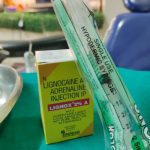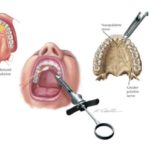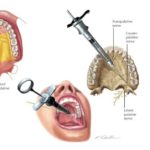Phentolamine Mesylate is an Alpha Adrenergic blocker which is used in Dentistry as a Reversal agent for Local anesthesia. It helps in reversing unwanted prolonged Anesthesia or Numbness and aids in faster recovery from Local anesthesia effect after the Procedure is done. Phentolamine Mesylate is most commonly used in Hypertension as it helps in Vasodilation […]
Search Results for: local anesthesia
Local Anesthesia Toxicity – Signs & Symptoms and Management
Local Anesthesia is the most commonly used medication in dentistry to provide anesthesia or pain control for most dental procedures involving teeth, gums and supporting soft tissue. But like any medication there are chances of toxicity to local anesthetic if the correct dosage is not administered. It is always recommended to calculate the Dosage of […]
Local Anesthesia Allergy and how to perform Skin Test in Dental Clinic
Allergic Reactions to Local Anesthesia is quite rare but when it does happen, it can turn complicated very fast and requires immediate response from the Dentist and Dental Staff to make sure that the vitals of the patient are kept Stable. Local Anesthesia is categorized into 2 types – Amides (Lidocaine, bupivacaine, prilocaine, articaine etc) […]
Local Anesthesia Syllabus and Chapters
Local Anesthesia is an integral part of Dental Treatments and it is important to have complete knowledge on every aspect related to Local Anesthesia right from Dental Anatomy to help in administering proper Local anesthesia to deciding the amount of local anesthesia to be given to a certain patient. You should also have a clear idea […]
Nasopalatine nerve block Technique – Local Anesthesia
Nasopalatine nerve block: Used to block the nasopalatine nerve. This is used to provide anesthesia to the Soft tissue of the Palatal aspect from the Canine to Canine. It is anesthetized as it emerges from the anterior palatine foramen located on the anterior palate region just behind the central incisors. Let us look in detail […]
Anterior or Greater Palatine Nerve Block – Local Anesthesia Technique
Anterior or Greater Palatine Nerve Block: Used to block the Anterior palatine nerve. As the name suggests it blocks the Anterior Palatine Nerve Block, the nerve is anesthetized as it exists the Greater Palatine Foramen which is located on the hard palate on the posterior portion. Let us look in detail about How to give […]
Why cannot the Dentist get my Teeth Numb with Local Anesthesia
Getting a Tooth numb before any procedure in the dental clinic is one of the main things which every Dentist would like to get and all the patients would feel comfortable with, but there are some or shall I say many situations when your Dentist cannot get your teeth numb even after multiple doses and […]
Inferior Alveolar Nerve block – Local Anesthesia Technique, Landmarks and Symptoms
It is sometimes called the Inferior Dental Nerve which gives off a motor branch supplying the Mylohyoid and the anterior belly of digastric and travels through the Mandibular foramen and enters the Mandible. After entering the Mandible it supplies to the following Mandibular Teeth: 2nd Premolar, 1st, 2nd, and 3rd Molars. It extends Anteriorly forming […]
Best Books to follow for Local Anesthesia in Dentistry
Local Anesthesia is a very important and integral part of Dentistry and every Dentist or Dental Student should be well versed with the knowledge and all the aspects of Local Anesthesia. There are many procedures which will be performed after administration of Local Anesthesia like General Extractions, Dis-Impactions of Third Molars, Root Canal Treatment, Periodontal […]
Infraorbital Nerve Block – Local Anesthesia Technique
Infra Orbital Nerve Block – Block of Anterior and Middle Superior Alveolar Nerves Inferior alveolar nerve block as the name suggests blocks the Infraorbital nerve block along with some other nerves which is used mainly when working in the Anterior Maxillary region. So let us see in detail about How to give Infra Orbital Nerve […]
Local Anesthesia Definition, Composition, Classification, Ideal properties and Complications
Local Anesthesia: Definition: It is a local state of loss of sensation without loss of consciousness, in a circumscribed area of the body due to a depression of, excitation in nerve endings or an inhibition of the conduction process in peripheral nerves. Local Anesthesia is most commonly used in Dental Treatments where the need to […]
Complications of Local Anesthesia
Local Anesthesia is useful in many dental treatment procedures and there are many complications associated with the administration technique and also with the composition of certain components of the agent present like allergic reactions and other conditions which are divided into Local and Systemic. One of the most common Complication seen in Syncope which can […]
Failure of Inferior Alveolar Nerve Block Anesthesia – Hot Tooth
Failure to achieve Inferior alveolar nerve block Local Anesthesia is most common problem many Dentists face during Root canal Treatment, it leads to the patient experiencing pain while pulp extirpation and increases difficulty along with consuming more time for the Dental Practitioner or Endodontist. Having facing many such cases even after maintaining proper Injection technique […]
Medications that interact with General Anesthesia
General Anesthesia is an integral part of Oral and Maxillofacial Surgery, it consists of many components that might interact with medications taken for other health issues. General Anesthesia is administered in Dental treatments such as surgeries for Orofacial trauma Trauma such as Le-Fort fractures, Prosthetic surgeries such as Orthognathic surgery, Large Tumors (Ameloblastoma) or Cyst […]










